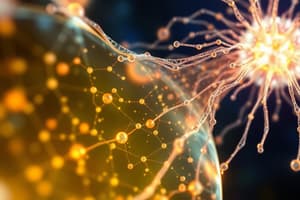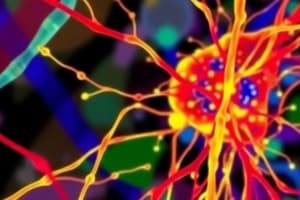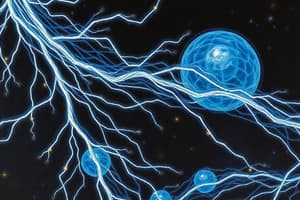Podcast
Questions and Answers
What is the primary function of labile microtubules?
What is the primary function of labile microtubules?
- They primarily serve to stabilize the cytoskeleton.
- They enable intracellular transport. (correct)
- They connect microtubules to other cellular structures. (correct)
- They initiate nucleation at the centrosome.
Which component is responsible for the nucleation of microtubules?
Which component is responsible for the nucleation of microtubules?
- Gamma-tubulin ring complex (correct)
- Centrosome proteins
- Alpha-tubulin
- Beta-tubulin
Which statement best describes the structure of the gamma-tubulin ring complex?
Which statement best describes the structure of the gamma-tubulin ring complex?
- It connects with other microtubules to enhance stability.
- It consists of 12 subunits that facilitate protofilament assembly.
- It is a single protein that serves as a microtubule stabilizer.
- It is composed of 13 subunits that initiate each protofilament. (correct)
What is NOT a function associated with labile microtubules?
What is NOT a function associated with labile microtubules?
Where does nucleation of microtubules occur?
Where does nucleation of microtubules occur?
What characterizes labile microtubules compared to stable microtubules?
What characterizes labile microtubules compared to stable microtubules?
What role does the mitotic spindle play regarding microtubules?
What role does the mitotic spindle play regarding microtubules?
What is the primary role of microtubules in cancer therapy?
What is the primary role of microtubules in cancer therapy?
Which statement accurately describes intermediate filaments?
Which statement accurately describes intermediate filaments?
What structural characteristics distinguish microtubules from intermediate filaments?
What structural characteristics distinguish microtubules from intermediate filaments?
What effect do microtubules have on cancer cells specifically?
What effect do microtubules have on cancer cells specifically?
Which of the following best describes the dynamic nature of microtubules?
Which of the following best describes the dynamic nature of microtubules?
What role does MAP2 play in relation to microtubules?
What role does MAP2 play in relation to microtubules?
What occurs at the GTP cap of microtubules?
What occurs at the GTP cap of microtubules?
Which statement accurately describes the structure of microtubules?
Which statement accurately describes the structure of microtubules?
Which statement about tubulin-GTP binding is true?
Which statement about tubulin-GTP binding is true?
How does Tau differ from MAP2 in terms of microtubule interaction?
How does Tau differ from MAP2 in terms of microtubule interaction?
What is the primary function of cilia in relation to the cell surfaces?
What is the primary function of cilia in relation to the cell surfaces?
What diameter do microtubules typically have?
What diameter do microtubules typically have?
Which component is responsible for intracellular transport as well as supporting cell division?
Which component is responsible for intracellular transport as well as supporting cell division?
Which statement regarding the active phase of cilia function is true?
Which statement regarding the active phase of cilia function is true?
What are actin filaments primarily made of?
What are actin filaments primarily made of?
What occurs during the recovery phase of cilia motion?
What occurs during the recovery phase of cilia motion?
What is a common role of microfilaments in cells?
What is a common role of microfilaments in cells?
In what capacity do cilia contribute beyond particle movement?
In what capacity do cilia contribute beyond particle movement?
What is the effect of destabilizing MAPs on microtubules?
What is the effect of destabilizing MAPs on microtubules?
What initiates polymerization of microtubules?
What initiates polymerization of microtubules?
What regulates the balance between polymerization and depolymerization of microtubules?
What regulates the balance between polymerization and depolymerization of microtubules?
How do microtubules facilitate cellular transport?
How do microtubules facilitate cellular transport?
What is the consequence of having a high concentration of destabilizing MAPs?
What is the consequence of having a high concentration of destabilizing MAPs?
What does GTP hydrolysis rate affect in microtubule dynamics?
What does GTP hydrolysis rate affect in microtubule dynamics?
What type of microtubule dynamics is associated with increased cellular activity?
What type of microtubule dynamics is associated with increased cellular activity?
Which factor is NOT directly involved in regulating microtubule dynamics?
Which factor is NOT directly involved in regulating microtubule dynamics?
What process allows microtubules to rapidly reorganize in response to cellular needs?
What process allows microtubules to rapidly reorganize in response to cellular needs?
What is the role of tubulin-GTP in microtubule dynamics?
What is the role of tubulin-GTP in microtubule dynamics?
What is the key feature of microtubules that defines their behavior in cellular environments?
What is the key feature of microtubules that defines their behavior in cellular environments?
How do microtubules respond during cellular need for rapid change?
How do microtubules respond during cellular need for rapid change?
What happens to microtubules after the addition of tubulin-GTP subunits?
What happens to microtubules after the addition of tubulin-GTP subunits?
In what manner does dynamic instability contribute to cellular functions?
In what manner does dynamic instability contribute to cellular functions?
Which statement best describes the cycles that microtubules undergo?
Which statement best describes the cycles that microtubules undergo?
What is the primary structural component that microtubules are composed of?
What is the primary structural component that microtubules are composed of?
Flashcards
Microtubules
Microtubules
Hollow cylinders made of tubulin dimers, found in cells, involved in cell shape, movement, and division.
Mitosis
Mitosis
The process of cell division, resulting in two daughter cells.
Apoptosis
Apoptosis
The process of programmed cell death, a natural mechanism to eliminate unwanted cells.
Mitotic Spindle
Mitotic Spindle
Signup and view all the flashcards
Microtubule-Targeting Drugs
Microtubule-Targeting Drugs
Signup and view all the flashcards
Cilia
Cilia
Signup and view all the flashcards
Active phase of Ciliary motion
Active phase of Ciliary motion
Signup and view all the flashcards
Recovery phase of Ciliary motion
Recovery phase of Ciliary motion
Signup and view all the flashcards
Actin Filaments (Microfilaments)
Actin Filaments (Microfilaments)
Signup and view all the flashcards
Labile MTs
Labile MTs
Signup and view all the flashcards
Stable MTs
Stable MTs
Signup and view all the flashcards
Microtubule nucleation
Microtubule nucleation
Signup and view all the flashcards
γ-tubulin ring complex (γ-TuRC)
γ-tubulin ring complex (γ-TuRC)
Signup and view all the flashcards
Centrosome
Centrosome
Signup and view all the flashcards
Intracellular transport
Intracellular transport
Signup and view all the flashcards
Tubulin Dimer
Tubulin Dimer
Signup and view all the flashcards
Protofilament
Protofilament
Signup and view all the flashcards
Microtubule Polymerization
Microtubule Polymerization
Signup and view all the flashcards
GTP Cap
GTP Cap
Signup and view all the flashcards
Microtubule Associated Proteins (MAPs)
Microtubule Associated Proteins (MAPs)
Signup and view all the flashcards
Dynamic Instability
Dynamic Instability
Signup and view all the flashcards
Microtubule Growth
Microtubule Growth
Signup and view all the flashcards
Microtubule Shrinkage
Microtubule Shrinkage
Signup and view all the flashcards
Rescue
Rescue
Signup and view all the flashcards
Dynamic Behavior of Microtubules
Dynamic Behavior of Microtubules
Signup and view all the flashcards
Destabilizing MAPs
Destabilizing MAPs
Signup and view all the flashcards
Tubulin-GTP concentration
Tubulin-GTP concentration
Signup and view all the flashcards
Destabilizing MAPs
Destabilizing MAPs
Signup and view all the flashcards
Dynamic microtubules
Dynamic microtubules
Signup and view all the flashcards
Microtubule transport
Microtubule transport
Signup and view all the flashcards
Tubulin-GTP and polymerization
Tubulin-GTP and polymerization
Signup and view all the flashcards
Study Notes
Microtubules: Structure and Function
- Microtubules are part of the eukaryotic cytoskeleton, a network of protein filaments.
- They are hollow cylinders, 25nm in diameter, made of tubulin dimers.
- Microtubules are dynamic; they can grow and shrink rapidly.
- They exhibit "dynamic instability," alternating between growth and shrinkage phases.
- Polarity: plus (+) end grows/shrinks faster, minus (-) end is anchored to the centrosome.
- Microtubules are involved in intracellular transport, cell division, and maintaining cell shape.
- Microtubules have a 9+2 arrangement in cilia and flagella (9 peripheral doublets and 2 central singlets).
- Dynein arms are motor proteins that cause sliding of microtubules to generate motion in cilia/flagella.
Microtubules in Cancer Therapy
- Some chemotherapy drugs target microtubules.
- Stabilizing agents (e.g., taxol) prevent microtubule depolymerization.
- Destabilizing agents (e.g., vinca alkaloids) prevent microtubule polymerization.
Microtubule-Associated Proteins (MAPs)
- MAPs regulate microtubule length and stability.
- Stabilizing MAPs promote growth and prevent shrinkage.
- Destabilizing MAPs promote shrinkage.
- Motor MAPs drive intracellular transport (kinesin and dynein).
Microtubule Assembly
- Microtubule assembly begins at the centrosome, with gamma-tubulin ring complexes.
- Tubulin-GTP dimers add to the plus (+) end, forming protofilaments.
- GTP hydrolysis and GTP cap loss lead to depolymerization.
- Treadmilling occurs when addition and removal at opposite ends maintain constant length.
Centrosome
- The centrosome is the main microtubule-organizing center (MTOC) in animal cells.
- Comprised of two perpendicular centrioles surrounded by pericentriolar material.
- Centrioles have a 9+0 arrangement of microtubule triplets.
Studying That Suits You
Use AI to generate personalized quizzes and flashcards to suit your learning preferences.
Related Documents
Description
This quiz explores the intricate functions of labile and stable microtubules, including their roles in nucleation, cancer therapy, and structural characteristics. Test your knowledge on the dynamic nature of microtubules, the function of intermediate filaments, and key proteins such as MAP2. Perfect for students studying cell biology or related fields.




